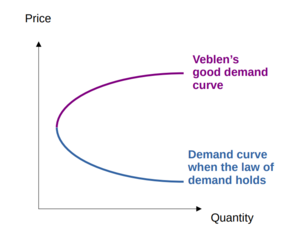Veblen effect: Difference between revisions
No edit summary |
No edit summary |
||
| Line 11: | Line 11: | ||
===Giffen Paradox; definition=== | ===Giffen Paradox; definition=== | ||
In addition of Veblen effect, there is only one type of goods that follows the reverse demand curve. According to the classical view, the more expensive a product is, the less demand there is for it. In reality, this does not represent the lowest tier product. According to Giffen's paradox, a '''Giffen good''' is a good whose quantity demanded by the consumer increases when its price increases, all other things remaining equal. It is due to the fact that consumers have to consume this good because there is no viable substitute to it and the good is necessary to meet the basic needs of the user. ''An example is the rising price of bread in England in the late 19th century. Despite rising prices, demand was also rising, especially among the poorest households <ref> Kasztalska | In addition of Veblen effect, there is only one type of goods that follows the reverse demand curve. According to the classical view, the more expensive a product is, the less demand there is for it. In reality, this does not represent the lowest tier product. According to Giffen's paradox, a '''Giffen good''' is a good whose quantity demanded by the consumer increases when its price increases, all other things remaining equal. It is due to the fact that consumers have to consume this good because there is no viable substitute to it and the good is necessary to meet the basic needs of the user. ''An example is the rising price of bread in England in the late 19th century. Despite rising prices, demand was also rising, especially among the poorest households <ref> Anastazja Kasztalska (2017), p.81 </ref>. | ||
| Line 25: | Line 25: | ||
==References== | ==References== | ||
* Kasztalska | * Anastazja Kasztalska (2017), [http://immi.ath.bielsko.pl/wp-content/uploads/2017/06/7_1.pdf ''THE ECONOMIC THEORY OF LUXURY GOODS, [Online] // International Marketing and Management of Innovations: International Scientific EJournal. N°2''], Management Department of University of Bielsko-Biala, Katowice. | ||
* Lynne Pepall & Joseph Reiff (2016), [https://reader.elsevier.com/reader/sd/pii/S0165176516302282?token=D49EBC20318899B82A3FA5261BF6921329D3231CD818E78E03B06C828D8A8A5054F9D2FD1241B72E1A0A5958572CC95B&originRegion=eu-west-1&originCreation=20221025214253 ''Economics Letters Volume 145''], University of Chicago Press, Duluth. | * Lynne Pepall & Joseph Reiff (2016), [https://reader.elsevier.com/reader/sd/pii/S0165176516302282?token=D49EBC20318899B82A3FA5261BF6921329D3231CD818E78E03B06C828D8A8A5054F9D2FD1241B72E1A0A5958572CC95B&originRegion=eu-west-1&originCreation=20221025214253 ''Economics Letters Volume 145''], University of Chicago Press, Duluth. | ||
* Judy Whitehead (2010), [https://www.taylorfrancis.com/books/mono/10.4324/9780203870617/microeconomics-judy-whitehead ''Microeconomics A Global Text''], Routledge, London. | * Judy Whitehead (2010), [https://www.taylorfrancis.com/books/mono/10.4324/9780203870617/microeconomics-judy-whitehead ''Microeconomics A Global Text''], Routledge, London. | ||
Revision as of 13:06, 26 October 2022
The Veblen effect is a phenomenon highlighted by the economist and sociologist Thorstein Veblen. A Veblen good is a type of luxury good for which demand increases as the price increases, in apparent contradiction to the law of demand.
Introduction
Many years ago Leibenstein (1950) emphasized the significance of the signal effect the way people consume. This signifies that the utility of a product increases or decreases depending on whether it is purchased and consumed by other consumers. It can also depend on wheter the good has an high or low cost. In marketing, people used to buy luxury goods to impress. It is known that most consumer tacitly accept that luxury goods are bought for social signaling ambitions. For example, artwork, designer clothes, vintage and luxury cars, jewelry, etc [1].
Veblen demand curve
Let's explain why Veblen demand curve is really exceptional. Actually, it is not really hard to recognize the demand curve for Veblen goods as it is really exceptional. The demand curve for Veblen goods has an upward slope that is the opposite of the typical demande curve which has a downward slope [2].
Differences between Veblen effect and Giffen paradox
Giffen Paradox; definition
In addition of Veblen effect, there is only one type of goods that follows the reverse demand curve. According to the classical view, the more expensive a product is, the less demand there is for it. In reality, this does not represent the lowest tier product. According to Giffen's paradox, a Giffen good is a good whose quantity demanded by the consumer increases when its price increases, all other things remaining equal. It is due to the fact that consumers have to consume this good because there is no viable substitute to it and the good is necessary to meet the basic needs of the user. An example is the rising price of bread in England in the late 19th century. Despite rising prices, demand was also rising, especially among the poorest households [3].
Veblen effect, conspicuous consumption and avertising
The Veblen effect, conventionally associated with 'conspicuous consumption', is now associated with branded products that are functioning the same way as cheaper products but grants a better social status valued by end users. That is indeed quite the definition of the conspicuous consumption[4].
All of the that is created by marketing and more especially; advertising. The social image implanted in a brand appellation is often the most important objective in a company's advertising strategy. This objective has gained more and more importance in contemporary times as technological and social forces amplifies the value of brand identity and its power over end users [5].
The objective of all that is to create a Veblen effect. In other words, nowadays, advertising is used to bring desire in the user to belong to a certain group of people that associated with a certain product. This is conspicuous consumption [6].
Footnotes
References
- Anastazja Kasztalska (2017), THE ECONOMIC THEORY OF LUXURY GOODS, [Online // International Marketing and Management of Innovations: International Scientific EJournal. N°2], Management Department of University of Bielsko-Biala, Katowice.
- Lynne Pepall & Joseph Reiff (2016), Economics Letters Volume 145, University of Chicago Press, Duluth.
- Judy Whitehead (2010), Microeconomics A Global Text, Routledge, London.
- Minas Kastanakis & George Balabanis (2011), Advances in Consumer Research Volume 38, University of Chicago Press, Duluth.
Author: MATHIEU Amaury
